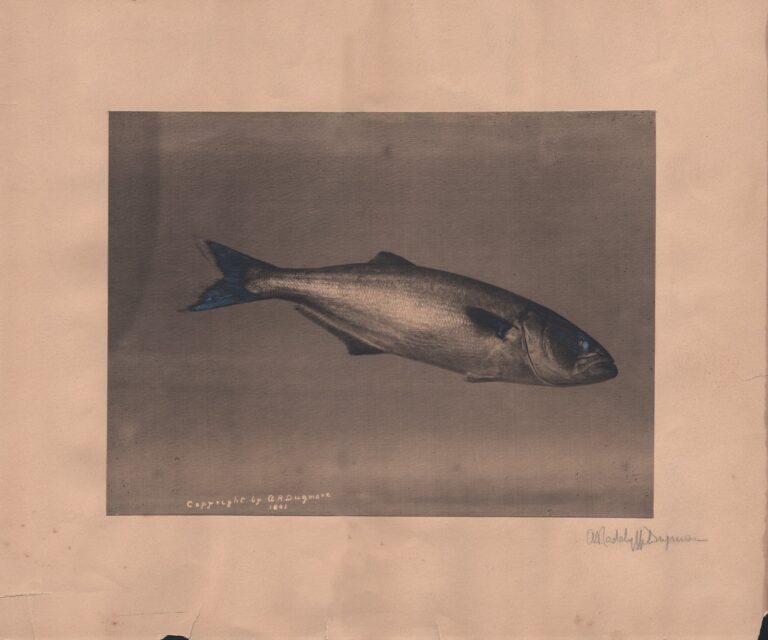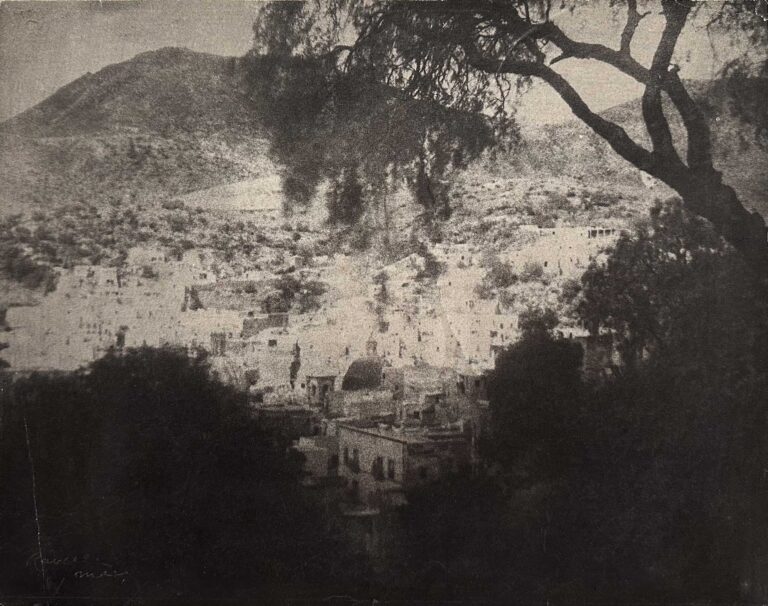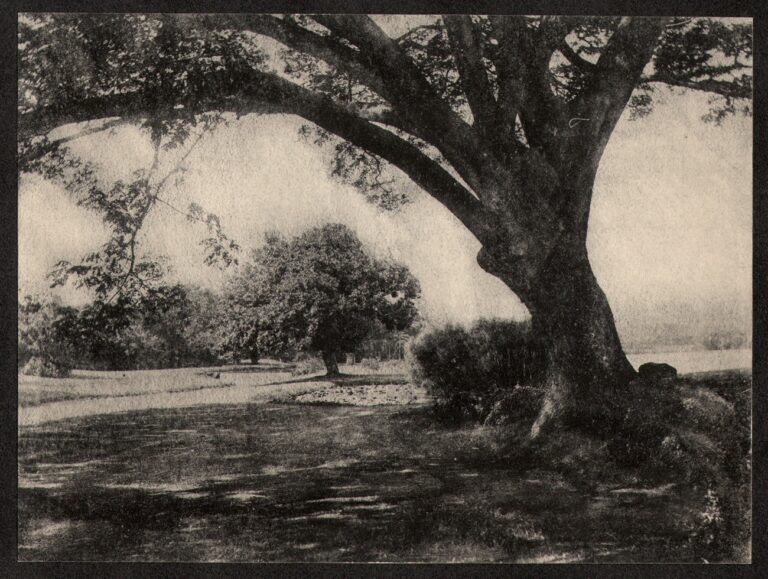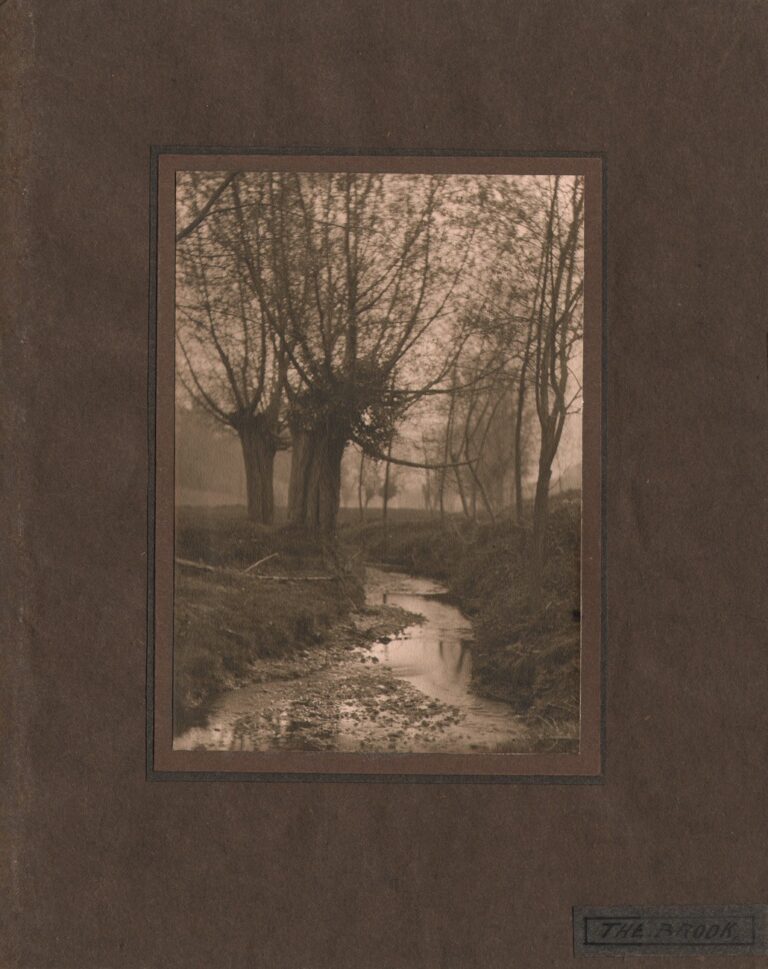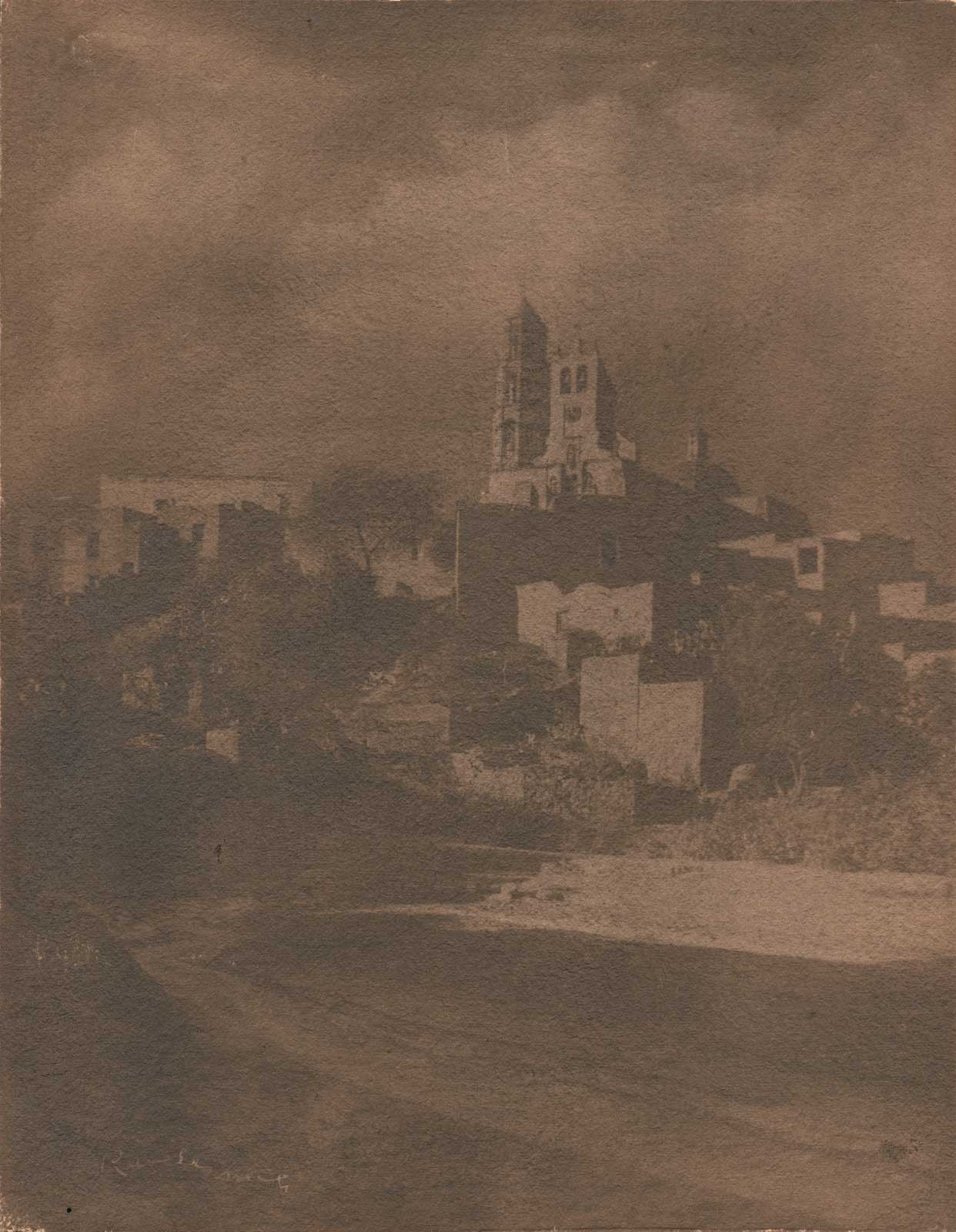
Marfil: Templo De Marfil De Arriba
Constructed in the Baroque style, the Templo De Marfil De Arriba church was photographed by Henry Ravell most likely ca. 1900-10. This vintage gum print, which originally came from a Mexico City estate, was used as the opening halftone illustration in the February, 1914 Century Magazine for a spread of four photographs titled Old Churches In Mexico. Titled Marfil, the copy states:
This was once a busy Mexican mining town. Only a few houses remain grouped about the church.
OLD CHURCHES IN MEXICO
Four Photographs By H. Ravell
The churches of Mexico, built about one hundred and fifty years ago, are a monument to a race of conquerors who extracted much loot from a subjected people. As part of the Spanish Colonial government, the church had a share in the taxation of rich mines and other industries, and lavished the proceeds on many churches and monasteries. The conquered Indians were put to work and directed by those who built the splendid temples of Spain. They produced massive structures, a combination of classical and oriental architecture with richly decorated interiors.
Surrounded by beautiful landscapes or placed in the streets of a town, the splendid tinted walls, tiled domes, and skilfully carved facades prove the Spaniards a great race of builders.
Further background on this church, which still stands today in Marfil, a suburb of Guanajuato in Mexico:
TEMPLO DE MARFIL DE ARRIBA
The church of San José y la Purísima Concepción is more colloquially known as La Iglesia de Arriba, or the “Church up Top”.
Although these days, Marfil is a suburb of Guanajuato, originally it was the site of the Real de Santiago de Marfíl, one of the four fortresses built to protect gold and silver deposits from raids by local Chichimeca warriors.
Construction was completed on December 2, 1757 and the building was dubbed “The Hospital”. It’s said that its construction was made possible by a businessman from Silao who, on his frequent visits to Guanajuato, used to pray in a hermitage on the same site, and, in thanks for the fortune he accumulated from having his prayers answered, he had the church built. Sadly, he died before he was able to build the monastery that he had also promised.
This was only the forerunner of the current building located on the hilltop so that its figure towered over the surrounding village of Marfil.
Due to its lofty position, the church was safe from the floods that reduced the city to ruins on several occasions and was officially declared the parish church following the deluge of 1905.
The entrance to the church is in the late baroque style. Around the back is a graveyard that continues to function to this day. (source:Un Museo Llamado Guanajuato website accessed January, 2019)
Timeline: Henry Ravell: 1864-1930
1864: Born January 2 in Wolcott, in the state of New York to Charles Henry Ravell (1833-1917) and Cornelia Dudley Ravell. (1840-1908)
1880: U.S. Census lists Ravell, 17 years old, living in Lyons, New York with the profession of photographer. At this time, he worked for his father Charles Henry Ravell, (C.H. Ravell professionally) who operated a commercial portrait studio on Canal Street in Lyons beginning in the 1860’s.
1882: An early reference to Ravell as a painter is printed as a short notice in The Democrat and Chronicle newspaper from Rochester, New York on November 26: “Henry Ravell, of Lyons, was in this city last night, on his return from Medina, (New York-editor) where he disposed of two of his latest paintings for $70.”
1883–1889: Between the ages of 19-25, depending on various published accounts, the photographer moved to Mexico after becoming an agent for Ten Eyck & Co. of Auburn, New York. The firm specialized in producing enlargements of photographs better known today as “Crayon or Pastel Portraits”. Using a solar enlarging camera, these so-called “parlor portraits” were typically made using copy negatives from an original photograph projected onto light-sensitive photographic papers and then embellishing the resulting print using pastels, monochrome or colored pencils. In 1876 Ten Eyck advertised: “common photographs into larger sizes for framing.” … “Plain Copies, and Fine India Ink, Water Colored and Oil Portraits.” More background found on process here.
1888: Before arriving in Mexico, Ravell most likely worked as a photographer in Minnesota alongside his father Charles Henry Ravell. From Langdon’s List of 19th & Early 20th Century Photographers, a listing for a studio in St. Paul, Minnesota: Ravell, Charles H., photographer, res 239 Selby Ave., St. Paul, MN (1888) City Directory. (see 1906 citation below)
1890: It is unclear if Henry came and went to Mexico from Minnesota, or if later published accounts of him were erroneous. Advertisement in The Saint Paul Globe newspaper on May 13 gives a possible clue as to when Henry Ravell may have struck out for Mexico, assuming he had been working for his father in the capacity of a retoucher at his St. Paul studio: Wanted, first-class re-toucher, at Ravell’s Photo Studio-: Western and Selby. (studio that year was located at 168 Western Ave. N. and the family lived at 376 Selby ave. Note: The Minnesota State Historical Society Directory of Minnesota Photographers lists the senior Ravell running his Western Ave. photo studio from 1890-2.
1895: The Minnesota State Census lists Henry Ravell’s occupation as “artist” while living with his parents and younger brother, Charles Ravell Jr. (whose occupation is newspaper advertising) in the city of St. Paul. Interestingly, his father Charles Ravell, now 61, lists his occupation as “Dining Hall Prop.”- Proprietor?) Note: the 1893-4 “Dual City Blue Book” for St. Paul home addresses has only two separate listings for C.H. Ravell and C.H. Ravell Jr. at 420 Selby Ave., but none for Henry Ravell.
1905: An early published example of Ravell’s, titled An Ox Cart, appears as an elaborate mounted and tipped halftone in the luxury portfolio publication Art In Photography, issued by the Photo Era Publishing Company of Boston.
1906: An article on The Art of Photography in the July issue of Bob Taylor’s Magazine mentions Ravell had previously worked in Minnesota: “Henry Ravell, after years of work in Minnesota, now confines himself exclusively to Mexican studies.”
1907: From the volume: List of Photograph Dealers with Index by Countries: published by The Massachusetts Library Club, 1907: Henry Ravell, Care W.W. Blake & Co., Gaute 6, Mexico City, Mexico. The volume also lists Ravell’s photographs of “Architecture and general views” (from Mexico) available through the Detroit Publishing Co. (p.16: Index by Countries)
1908: “Some Mexican Churches” From Photographs made by Henry Ravell with text by Lockwood De Forest published in the Century Illustrated Monthly Magazine for May. De Forest concludes the article by giving some excellent early background on the artist:
So much interest is being taken in the artistic development of photography that something should be said about Ravell and his work. His father was a photographer in one of the photographic enlargement firms at Auburn, New York, (1.) which in the seventies and early eighties was the most important center of this industry in the world. Ten Eyck & Co., the largest of the ten principal concerns, did a business of $75,000 a year, and had two hundred agents scattered nearly all over the world. even as far as Australia. They employed not only a staff of photographers but of artists, and were prepared to furnish portraits from eight by ten to life-size in photograph or any other medium, including oil. Some of our successful artists of to-day began there. Ravell, after being his father’s assistant as a boy, studied water-color painting with Henry W. Ranger, and twenty-five years ago was sent to Mexico as an agent. he has been at work there ever since, painting a little, but mainly photographing. He has had to work everything out for himself. His early training has given him exceptional skill in developing different printing processes, which he has brought to great excellence. Last summer he started experiments in color-printing. His process is simple. Instead of introducing colors on the negatives, as in the lumière process, he is using the colors in the sensitizer of the printing paper. The specimens he has sent me are printed in three or four colors. Each print is finished, recoated all over with the sensitizer with the next color, and again printed. This is done for each color separately, the black print coming last, as in the regular color-printing process. (pp. 28-29)
1909: January 2: Review of his work appears as part of the Fifth American Photographic Salon that opened in Pittsburgh, PA in the pages of The Index, Pittsburgh’s Illustrated Weekly: “The most wonderful and striking collection contributed by one man is that of Henry Ravell, of Mexico. All his pictures are in multiple gum or oil and, though many will doubt that the marvelous coloring was obtained by a purely photographic process, this is absolutely the case. “The Street of the Arch,” reproduced on this page, gives an idea of the strength of his composition, but conveys no idea of its wonderful vividness.” (p. 8)
– Ravell was pronounced “King of the Photographers” in the pages of the Pan-American Magazine for April, along with published examples of his work- “Photo Graphic Art Studies” :
We take off our hat to the true artist in any profession, law or letters, medicine or photography. If a man devotes himself conscientiously to the achievement of an ideal in his work, it is but just that he should expect the praise of his fellow men if he succeeds. And if there ever was a genius of photography, one whose work reveals the master hand of the true artist, it is Henry Ravell, of Cuernavava, Morelos. He has lifted colo-photography from a purely mechanical process to the Olympian heights of Ara, and he has been content to overlook the commercial phase of his work, which might have made him a rich man in a more populous city of the world, in order that he might have as the background for his beautiful lines that most picturesque of quaint old towns, Cuernavaca. And yet fame has not permitted Henry Ravell to live out his quiet span in that little town unknown to his fellow artists. Cuernavaca is coming to be a Mecca for the craft. and each carries away pictures that are veritable dreams of art, embellished with every color and tint of the rainbow, and more true to their subjects than any work of landscape or portrait painters. George Lockwood de Forest,(sic) perhaps the foremost of American landscape artists, was among the first to sing the praise of Ravell, and quite lately J. C. Nicoll, president of the American Water Color Society of New York, added his tribute to that of others who recognize in Ravell the king of photographers. (p. 306)
1911: In the guidebook Terry’s Mexico: Handbook for Travellers under the heading Photographs, Views, Colored Post-cards for Mexico City shops, the following notice appeared: “The beautiful color-photography work by H. Ravell, and the excellent views by Cox, by Scott, and by Waite make artistic souvenirs: on sale at the Sonora News Co. store.” (p. 242)
1914: Spread in the February issue of The Century Magazine titled Old Churches In Mexico featuring four, full-page halftones of gum prints by Ravell, including one in Marfil known as the Templo De Marfil De Arriba, or the “Church up Top”.
-Ravell moves back to the United States from Cuernavaca, most likely a result of the ongoing Mexican Civil War, (Mexican Revolution) and settles in Los Angeles, California. Later, in 1921, an exhibit references him as being from Laguna Beach, part of the Los Angeles metropolitan area. (Death Certificate states he resided at same LA address for 16 years)
1916: Eight-page spread of full-page halftones made from gum prints of Mexican scenes published in the December issue of Harper’s Magazine titled Vanishing Mexico: A Series of Pictures By H. Ravell”. Now residing in California, the artist most likely supplied the following lines printed with the spread, although it is not signed:
“A rude hand has been laid upon Mexico. Under the stress and upheaval of revolution the ancient culture, old-time customs and picturesque life are breaking down. These pictures of Mexican scenes are typical of its old-world dignity and beauty, but they present a Mexico that is slowly vanishing.” (p. 97)
– A short biography of Ravell in the 1978 volume Pictorial Photography in Britain 1900-1920 states he had left Mexico by 1916 after rebels destroyed his Cuernavaca studio and includes other background on his career: “In about 1885 he travelled to Mexico, where he became the first artist to obtain any national recognition. He also used photography in his efforts to capture the vanishing way of Mexican life. In 1908 a number of his painterly gum prints were exhibited at the Thurber Gallery. In 1912, he and several other artists were commissioned by the Mexican Government to portray the country of Mexico, some of the resulting work was sent to America. In 1916 an article entitled “Cathedrals of Mexico”, illustrated by his work, was published in Harper’s magazine. About this time he left Mexico, almost as a refugee. His studio in Cuernavaca was destroyed by rebels. He moved to California where he began to photograph near Carmel and settled at Santa Barbara.” (p. 83)
1917: Nine, full-page halftones of gum prints of Mexican scenes, including the frontis, by Ravell reproduced in the volume Diplomatic Days by Edith O’Shaughnessy, published by Harper & Brothers. Shaughnessy collected and displayed some of Ravell’s photographs in the American Embassy in Mexico. She was a journalist, biographer, film screenwriter and wife of United States Chargé de Affairs in Mexico, Nelson O’Shaughnessy. This took place during the early years of the Mexican Revolution where she was both a witness and a participant in Mexican political affairs during the presidency of Francisco I. Madero and Victoriano Huerta. (Wikipedia)
1919: Exhibition of 93 photographs displayed at the Albright Art Gallery in Buffalo, New York from February 22- March 31.
PHOTOGRAPHS BY H. RAVELL AT THE ALBRIGHT ART GALLERY
THE collection of photographs by H. Ravell—which was on view in the gallery during the last week in February and all of March—is very unique and valuable. These photographs are technically known as gum-prints and have all the painter’s quality in their execution. They do not impress one as photographs but rather as work directly from the artist’s brush. The photographs were made by H. Ravell who is now in Santa Barbara. Many of the pictures were taken near Carmel, California, a seashore of much variety where the fantastic cypress trees with their twisted dramatic forms produce wonderful compositions against sea and sky.
Gum-printing is a method of fixing pigment to paper, the image being given by a photographic negative, and the lights and darks by the depth of printing. The materials used are paper, gum-arabic, or gelatin bichromate of potassium, and pigment. The paper is covered with a solution of the three ingredients and when dry is exposed to the light in contact with a negative. It is then soaked in water until that part of the pigment not fastened to the paper by the action of light is washed away.
This is but a short description of the remarkable exhibition of photographs shown at the Albright Art Gallery. It was seen by many art lovers and appreciated especially by all of those interested in artistic photography.
(p. 67: Academy Notes: The Buffalo Fine Arts Academy: Albright Art Gallery: Buffalo, New York: vol. XIV: Jan.-Oct. 1919)
– Photographs by H. Ravell at the Cleveland Museum of Art: November 16-December 5. According to the CMA database, the show was extended from December 30-January 10, 1919.
– January: Exhibition of gum prints at The Art Institute of Chicago. From their Bulletin: “The Ravell photographs, of Mexican and southern California subjects, have already been shown at Pratt Institute and at the Cleveland Museum of Art. Mr. Ravell lived for many years in Cuernavaca, Mexico. He has obtained remarkable results with gum printing, and many of his prints look like the work of a painter.” (February: Vol. 13, No. 2, p. 26)
– Exhibit of his gum prints shown at the Long Beach Public Library from February 1-29. The American Art Annual for 1920 also lists the artist as showing gum prints between 1919-20 at the Friday Morning Club, located at 940 S. Figueroa St. in Los Angeles.
1920: U.S. Census notes Ravell living in Laguna Beach, CA with his profession listed as Gum Printer and Industry being Photography.
1930: Henry Ravell dies as a result of an apoplectic stroke with complications on January 20th. His death certificate lists him as single with the occupation of artist and residing at 1221 S. Kennore (sic-Kenwood) in Los Angeles, California. Cremated, he is later interred in the family plot at Glenside Cemetery in Wolcott, New York.
(Note: a 1929 address for the artist printed in The American Annual of Photography lists it as 1221 So. Kenwood Ave. in Los Angeles.)
Major Holdings:
– The Metropolitan Museum of Art: New York: 15 photographs donated to the museum in 1930 by Florence D.R. Lothrop in memory of her brother.
–Museum of Wayne County History, Lyons New York. The following list of 39 original examples of Ravell’s work in a variety of media was personally compiled by the owner of PhotoSeed in a visit to the museum on August 23, 2019:
– three watercolor drawings, ca. 1915-20 showing cypress trees at Pebble Beach, California.
– Ca. 1885 gauche and oil? on paper portrait of John Lee Cole, (1838-1927) an 1859 graduate of Yale and grandson of the Rev. John Cole, a founder with John Wesley of the Methodist Church in the U.S. Cole was engaged in farming in Lyons after graduation and then served as principal of the Union School; afterwards taught at Louisville (Ky ) Conference Seminary until the beginning of the Civil War; subsequently returned to Lyons, studied law, and was admitted to the bar in June, 1862; engaged in the banking business in Lyons for some years under firm name of Mirick & Cole, later practiced law in New York City for a time and engaged in farming in Lyons; M.A. Syracuse 1875; member Methodist Episcopal Church, Lyons.
– one kallitype print ca. 1900-15 labeled “Street of the Church” (Taxco, Mex.) with additional unidentified inventory number “33” written on label to print support verso.
– three multiple gum prints ca. 1907-14: 1. untitled marine landscape: Mexico or California, showing cliff face in foreground with ocean and sky in background and unidentified inventory number “156” on label to print support verso. 2. Documentary style marketplace study of six people titled “Mexican Vegetable Seller”. 3. Profile portrait of boy in a marketplace wearing a sombrero hat titled “Mexican Youth”. ✻
– two gum? paper negatives ca. 1900-15: 1. Marine scenic landscape with unidentified inventory number “30” & Wayne museum inventory # Pi 176L written on label to negative verso. 2. Mexican? study titled “Woman + Child at the Stream” on masking tape strip to support verso.
– 18 gum prints ca. 1900-15 of Mexican scenes and subjects: 1. Market scene, Mexico. A multiple gum variant of this is “Lunching in the Market Place” held by Metropolitan Museum in N.Y.-accession 30.89.13. 2. “Side Wall Borda Church, Mexico”. 3. “Mexican Indian Woman” with unidentified inventory number “28” on label to print support verso. 4. “Church, Mexico” with unidentified inventory number “2” and $5.00 on label to print support verso. 5. “Holy Well Guadalupe, Mexico” with unidentified inventory number “53”, and Wayne museum # “Pi 176n” on label to print support verso. 6. Untitled architectural study showing wall and staircase in foreground with village buildings in background and Wayne museum inventory number “Pi 360a” to folder. 7. “Mexican Laundress” with Wayne museum inventory # “Pi 360b” on label to print support verso. 8. “Churubusco Church near Mexico City” (title from 1978 Wayne museum exhibit catalogue) 9. “Taxco, Mexico”. Marketplace study (very dark print) showing church with two towers in background. 10. “Church Dome- Churubusco Mexico”. Gum variant: (image flipped) “A Church Dome at Cuernavaca, Mexico” held by Metropolitan Museum in N.Y.-accession 30.89.12. 11. “Eating Tent-Taxco, Mexico”. 12. “Church Tower”. 13. “Chapel of the Holy Well near Mexico City”. 14. “Going to Mass- Cathedral Entrance Cuernavaca, Mexico”. 15. “Stone Carved Facade Aquascaluntes, Mexico”. 16. “Mexican Peon”. Titled “A Mexican Peon” in 1978 Wayne museum catalogue showing a profile of a gentleman wearing an embroidered sombrero. 17. “Valenciana Church- Mexico”. 18. “Church of Cuernavaca by Moonlight”. ✻
– 11 gum prints ca. 1915-20 of California scenes and subjects: 1. “Big Splash”. Marine shore study showing waves splashing against boulders: with unidentified inventory number “122” and $12.00 on label to print support verso; with additional red postmark for Santa Barbara, CA to support verso. 2. Unmounted and untitled marine shore study on translucent paper with unidentified inventory number “116” on label to print support verso. 3. Another untitled and unmounted marine shore study with less wave action (same location?) and unidentified inventory number “101” on label to print support verso. 4. Untitled and unmounted marine shore study with unidentified inventory number “82” on label to print support verso and written Wayne museum inventory # “Pi 176i” to print verso. 5. “Cypress Tree”, with unidentified inventory number “18” and “$3.00” on label to print support verso and written Wayne museum inventory # “Pi 176d” to print verso. 6. “Tree”, showing a cypress overlooking shoreline with unidentified inventory number “4” and “$3.00” on label to print support verso and written Wayne museum inventory # “Pi 176c” to print verso. 7. Untitled landscape of twisted cypress tree set in foreground with other cypress trees in background: unidentified inventory number “5” and “$3.00” on label to print support verso and written Wayne museum inventory # “Pi 176b” to print verso. 8. “Pine and Cypress, Pebble Beach”: unidentified inventory number “17” and “$3.00” on label to print support verso and written Wayne museum inventory # “Pi 176a” to print verso; another example in gum: “Fog and Cypress Trees” held by Metropolitan Museum in N.Y.-accession 30.89.9. 9. Untitled landscape study of grouping of cypress trees set against shoreline. 10. “All Tangled Up”: showing landscape of intertwining limbs of a very large cypress tree set against shoreline. 11. “Clouds + Water”: showing a bisected marine landscape of a shoreline with wave action on boulders and cloud filled sky. ✻
✻: Provenance for these gum prints was Henry L. Trebert of Rochester, New York, who apparently donated them to the Wayne County Historical Society at an unknown date, but before 1977, when curator Gary Walrath began researching Ravell and the subsequent 1978 exhibit of his work at the Wayne County museum.
– University of California at Berkeley Libraries: WorldCat lists holdings by Ravell here as 34 items collectively known as “Photographs from Mexico”, including “photographic prints and photomechanical reproductions- “Primarily views of buildings and street scenes from Cuernavaca, Xochimilco, and other Mexican locations. Two appear to be San Francisco, Calif. views.” (BANC PIC 1978.134–AX) (Note: UC Berkeley misattributes overall collection to the artist’s father, Charles Henry Ravell rather than to Henry Ravell.)
– The George Eastman Museum: A 1977 letter addressed to William Jenkins, then Associate Curator for 20th Century Photography at the International Museum of Photography at George Eastman House by Gary Walrath, then Curator and Educational Service Director for the Wayne County Historical Society who mounted a 1978 exhibit on Henry Ravell, listed ten prints by the artist held in Rochester. It is unclear if these prints still reside in their archive. An additional three prints by Ravell are listed here from a spot check in July, 2020 on the museum’s online portal.
–1977 listing: 1. “Boat at Ocotlan, Santa Barbara” (74:016:54) 2. Untitled (Group Portrait) (74:016:87) 3. “Mexican Market Women” (74:016:106) 4. “Mother and Child” (untitled) (74:016:89) 5. “A Bit of the Market Place” (72:196:14) 6. “Outside Worshippers, Services Within” (72:196:283) 7. Untitled negative (74:016:165) 8. “A Cloud that Passed over Taxco” (74:016:75) 9. Untitled seascape (74:016:75) 10. “La Criada” (72:196:18).
–July, 2020 listing: 1. Untitled seascape Gum bichromate print: (1974.0016.0003) 2. Untitled seascape Gum bichromate print: (1974.0016.0004) 3. Photograph, unknown process: “Church belfry and tiled domes Aguascalientes, Mexico” (1972.0196.0070).
– California Museum of Photography, Riverside, California (UCR Arts): 13 Henry Ravell photographs believed to have been donated in 1984.
1. At The Fountain: 1984.0023.0005; 2. Cathedral: 1984.0023.0004; 3. Corn Sellers, Kneeling at Church Door While Mass is Chanted Inside 1984.0023.0011; 4. Mexican Buildings 1984.0023.0009; 5. Mexican Cathedral 1984.0023.0014; 6. Mexican Charro 1984.0023.0012; 7. Mexican Church 1984.0023.0006; 8. Mexican Peon Boy 1984.0023.0015; 9. Mexican Scene 1984.0023.0007; 10. Night Scene (Trees) 1984.0023.0008; 11. Street Scene 1984.0023.0010; 12. Viga Canal, near Mexico City 1984.0023.0013; 13. Water Carriers, Guanajuato 1984.0023.0003.
Print notes, recto: signed in lower left of print, possibly with a colored pencil: Ravell (Mex) ? ; one pinhole at lower left corner: verso: adhesive and primary support remnants to upper margin.
Provenance: acquired by this archive in August, 2018 from California dealer who stated it came from a Mexico City estate.
1. It was actually Henry Ravell who worked at the Ten Eyck firm in Auburn. See: “Two Auburn Artists”, in The Auburn Citizen (New York state newspaper) for Friday, May 15, 1908: …”A mistake occurs in the statement regarding Mr. Ravell’s father: His father was engaged at Lyons, New York, while the son was employed in this city.”
